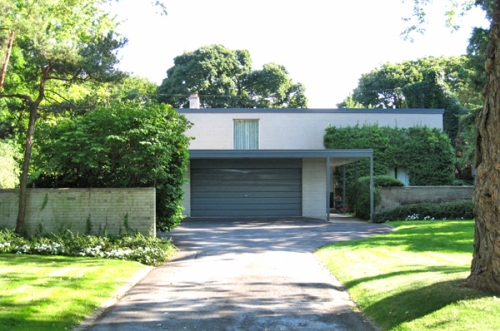Atop the escarpment above Davenport Road and just east of Spadina House, Ardwold Gate meanders through what was once the estate of Sir John Craig and Lady Eaton. Ardwold (“high on a green hill” in Gaelic) was their enormous, opulent Italianate manse, completed in 1911 and demolished only 25 years later. The grounds were then subdivided and upscale homes began to rise among the aged oak trees.
In addition to traditional Georgian and Colonial styles, Ardwold Gate boasts two notable Modernist residences. 17 Ardwold Gate was designed by Gordon Adamson & Associates for St. Clair Balfour, president of the then-powerful Southam newspaper chain, and completed in 1960. The two-storey house presents a very private public face: a starkly rectilinear façade of off-white sandlime brick framed in black steel is relieved only by three windows arranged in an asymmetrical pattern. Low garden walls of matching brick further distance the house from the street. At the rear, however, rows of sliding glass doors open onto a full-width balcony and terrace, capturing southern sunlight and capitalizing upon superlative views over the city below. The Balfour house was a finalist in the 1961 Massey Medals for Architecture competition.
At 95 Ardwold Gate is the Richard Mauran residence, designed by Estonian-Canadian architect Taivo Kapsi and completed in 1968. It’s a striking and highly unusual example of a Brutalist house: the entire structure, including the exterior and interior walls, is of cast-in-place concrete. Kapsi used saw-cut timber forms to achieve a raw, rough-textured finish, the prominent striations adding surface interest and emphasizing the three-dimensional effect of the house’s interlocking vertical and horizontal planes. A front courtyard is screened from view; at the rear, cantilevered terraces appear to float within the dense foliage of Roycroft Park. The weighty, almost primal effect of the concrete is effectively countered by broad expanses of clear glass. Ceilings of cedar boards add a tactile warmth. The second-floor balcony overlooking the street was later filled in, slightly disrupting the house’s visual rhythm but not compromising its powerful presence.
Tragically, Kapsi didn’t live to see his work completed. He died in August 1967 at the age of 31, following an altercation with intruders at a cottage north of Toronto. The Mauran house stands as a testament to his unrealized potential as an architect.

